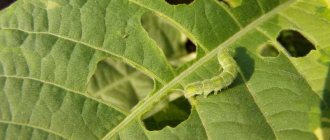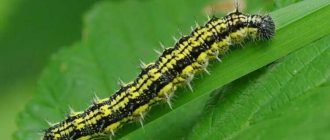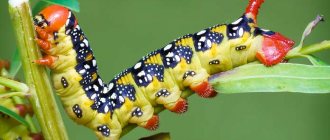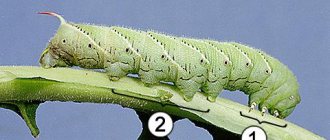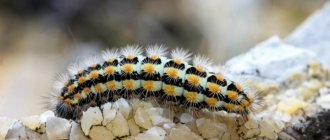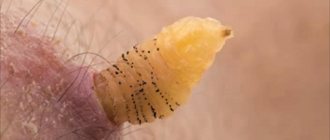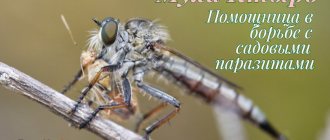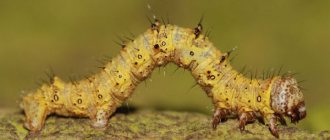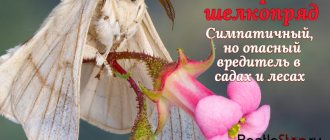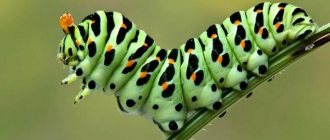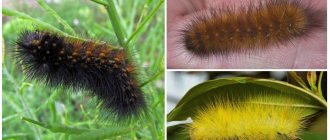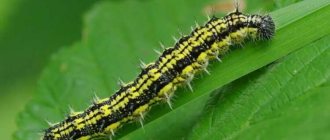Description of the caterpillar Lonomia
Name: Lonomia Lat.: Lonomia
Class: Insects - Insecta Order: Lepidoptera - Lepidoptera Family: Peacock-eyes - Saturniidae
| Habitats: | tropics and subtropics |
| Dangerous for: | people and animals |
| Peculiarities: | the most dangerous genus of caterpillars |
Lonomy caterpillar.
The most dangerous caterpillars are representatives of the genus Lonomy. They have a deadly venom on their spines - a strong, natural toxin. The brownish-green color helps to camouflage. Sometimes they merge with the bark of trees.
Brighter individuals can also remain unnoticed, because they find the most inconspicuous place for themselves. Color ranges from beige to light orange and pink. The structure is identical to fleecy fabric or plush.
Later it becomes a harmless butterfly belonging to the peacock-eye family. The wings are usually open. Length ranges from 4.5 to 7 cm.
Lonomy.
Habitat and lifestyle
Lonomy is a heat-loving insect. They live in:
- Brazil;
- Uruguay;
- Paraguay;
- Argentina.
Food preferences
Insects prefer peach, avocado, and pear in food.
Lifespan
The lifespan of the caterpillar is short - 14 days.
Habitat
Caterpillars are afraid of sunlight and look for a secluded corner in the shade. Moisture is another important criterion for normal development.
Danger
Lonomyia is difficult to detect. Because of this, people may touch a tree or foliage without paying attention to it.
Probability of meeting
Individuals create colonies, there is a possibility of collision with several insects.
Caterpillars pose a danger due to the content of a powerful toxin that can cause irritation in the human body. Even death is possible.
Lonomy is the most poisonous caterpillar in the world
Lonomia obliqua is the most poisonous caterpillar from South America. It is responsible for many human deaths, especially in southern Brazil. Its venom has also been the subject of numerous medical studies.
These are caterpillars ranging from 4.5 to 8 centimeters in length, ranging from green to brown in color. They are very difficult to notice, as they are perfectly camouflaged on leaves and trees.
Caterpillars of many species can cause irritation with body hairs, which are poisonous and easily separated from their body. However, for a long time, it was unknown that the lonomia goose could produce toxins that in sufficient quantities could kill a person. Lonomia lives in the south of Brazil: Rio Grande do Sul, Santa Catarina, Parana. The species continues to spread in southeastern Brazil, where recent casualties have been reported in the states of São Paulo, Rio de Janeiro, and Minas Gerais. Lanomia was found even in Uruguay, Paraguay and Argentina.
The species became world famous when an epidemic occurred in an agricultural community in Rio Grande do Sul. Doctors were concerned when dozens of patients came in with the same symptoms. Hematomas and gangrene increased throughout the body, and eventually caused cerebral hemorrhage and death. At first, the cause of the disease was not determined, but after examining the places that were indicated by the victims, the lonomia caterpillar was identified. Their spines completely cover the entire body, and each cluster of spines can easily pierce the skin and release toxins into the victim. Further research showed that at the base of each part of the spine there is a sac where toxins are stored. As soon as a person touches the lonomy, he will immediately receive a life-threatening dose of toxins.
The number of serious injuries and deaths increased every year, and there was no concrete record of proper treatment.
But still, there were several first aid tips; after contact with this terrible caterpillar, you should immediately remove the hairs from the wound. Adhesive tape is very helpful here; it can be glued and removed several times. The wound should also be cleaned with soapy water. And, of course, immediately consult a doctor. But as the number of victims grew, scientists at the Butantan Institute from Sao Paulo produced a cure. If administered no later than 12-24 hours after contact with lonomia, it will save your life. Tags Insect Planet The most dangerous animals
The danger of lonomia
Dangerous caterpillar Lonomia.
Growths similar to spruce branches are very dangerous. They facilitate the penetration of dangerous poison into the circulatory system. Insects are known to sting. Predators die from this poison, but for people the outcome varies.
With one touch, a sharp thorn pricks and the poison begins to spread . The most common consequences are brain hemorrhages and internal bleeding.
The poison makes blood vessels brittle and affects clotting. Along with these problems, it can provoke renal failure, coma, hemolysis, and death.
On contact there is pain. Later it subsides and many hemorrhages appear. It is very important to provide assistance within 24 hours.
Only this species has this level of toxicity.
This can be counteracted by administering an antidote . It neutralizes toxins. The difficulty lies in the fact that people do not always consider lonomia dangerous. However, symptoms can progress rapidly and cause lonomyasis. In this case, problems cannot be avoided.
The first incident was recorded in Rio Grand de Sol. An epidemic was detected among farmers in 1983. All had burns and spots similar to gangrene. It is worth noting that the number of deaths is 1.7% of all those stung. This is 0.1% less than from rattlesnake bites.
There are also a number of beautiful but dangerous caterpillars in nature.
The most dangerous caterpillar on the planet - Lonomia Obliqua - 17 photos
This Lonomia Obliqua is the most dangerous caterpillar in the world . Meeting her, or rather touching her, threatens you with internal bleeding and even death. These caterpillars live on trees in the southern regions of Brazil. Those who suffer are mainly tourists who lean against trees, not knowing about the existence of these caterpillars. Let's look at this deadly beauty and its consequences.
In Brazil, Argentina, and Uruguay there is a harmless moth from the family Peacock-eyes, or Saturnia, (lat. Saturniidae), genus Lonomia. Their larvae possess a deadly “weapon” - the most powerful natural insect toxin known.
In the tropical forests of southern Brazil, the Lonomia caterpillar is called the “lazy clown.” Unfortunately, this name does not reflect the true essence of this insect. Touching this creature can result in kidney failure, destruction of red blood cells and hemorrhages in the tissue. What's most unpleasant is that these caterpillars are perfectly camouflaged under the surrounding foliage and plants - it is almost impossible to see the lonomia.
Lonomia Obliqua caterpillars reach 7 cm in length. The caterpillars live on tree trunks, where they are very difficult to notice. They are greenish-brown in color with branched, fir-tree-shaped, green-colored spines. A distinctive feature of Lonomia Obliqua is the white "U" shaped spot on its back.
As you may have guessed, meeting such an insect will not bring anything good. But if they touch several at once, there will almost certainly be death. Unfortunately, several deaths are reported each year from exposure to lonomia. The only “positive” thing is that the caterpillar only appears for a few months each year. From the caterpillars, unremarkable butterflies then appear, which are not dangerous to humans.
Lonomia is a master of camouflage at all stages of its life cycle.
The “plumage” of the caterpillars is sharp, branched spines of greenish-gray color. If you look at an enlarged “branch” of such thorns, you might think for a moment that we are looking at a spruce paw. The toxin belongs to the class of anticoagulants. In simple terms, it blocks blood clotting. It destroys fibrinogen, a protein involved in blood clotting. The injected dose of poison upon contact of human skin with a caterpillar is a thousand times less than, for example, the dose of poison that a rattlesnake “gives” to the bitten person. However, the effect of this microscopic amount is amazing. The result is not only the inability to stop bleeding from a fresh wound, but also hemorrhages in the brain (result - apoplexy), and in the glomeruli of the kidneys (result - acute renal failure), and in general throughout the body (fatal multiple organ hemorrhage - multiple bleedings in all internal organs). This allows us to say that we have, perhaps, the most powerful natural insect toxin on the planet.
The venom of lonomia does not act immediately: first, pain is felt at the site of contact of the skin with the caterpillar, then it recedes, but huge hemorrhages appear on the body, and then, in the absence of treatment, any of the above ailments can develop. Brazilian doctors have developed a special antidote against the lonomia toxin, but it must be administered within 24 hours after contact with the caterpillars, which is not always achievable (sometimes a person does not even notice the “attack”).
The first human encounter with lonomia was widely publicized when a strange epidemic occurred among farmers in Rio Grand de Sol in 1983. Doctors were puzzled as patients arrived with the same symptoms: burns and gangrene-like spots spreading throughout the body. Severe cerebral hemorrhage and death occurred in several cases.
To date, the known proportion of fatal cases for humans is 1.7%, compared to a rattlesnake bite - 1.8%. The clinical picture depends on the amount of poison received. The person experiences a moderate to intense burning sensation and swelling of the area, leading to small hemorrhages in the mucous membrane or scars. In severe cases, hemodynamic disturbances occur in the body: gastrointestinal bleeding, kidney, lung and central nervous system bleeding. The poison can affect the kidneys and lead to kidney failure. Symptoms of the disease appear 1-12 hours after exposure.
The problem is that in addition to tropical jungles, caterpillars are often found in orchards. Lonomy is mobile throughout the day. They love shade and moisture, and therefore their natural habitat is in the forest, but they can also end up in the courtyard of residential buildings. So our advice to you: avoid any contact with unidentified objects, plants, animals while staying in Southern Brazil.
So, when going to travel to tropical countries, be very careful and careful.
Sometimes ordinary curiosity can play a cruel joke on a person. Reproduction of articles and photographs is permitted only with a hyperlink to the site:
| Kitten in a hammock | Roses and glasses of wine | Carpathians photo winter |
| Pink roses on a white background | Wallpaper winter snow | Pictures of winter mountains |
| Photo autumn rain | Mountain autumn | Pictures of jasmine flowers |
| Pictures of blue roses | Photo of London in winter | Pictures of bright flowers |
